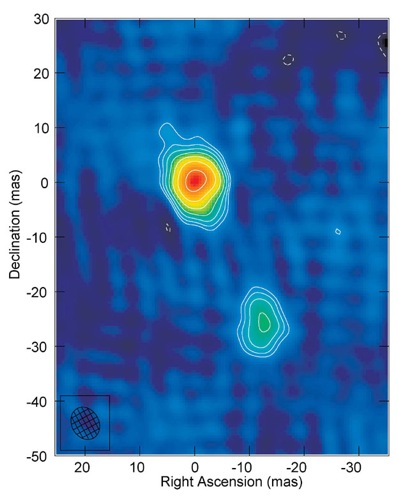|

Top Stories

|

|
 |
 |



Cassini sees collisions of moonlets in Saturn’s ring ...rapid changes in Saturn’s F ring can be attributed to small moonlets embedded within the ring causing perturbations and collisions....
read more

Extremely little telescope to hunt for Earthlike planets
...KELT will become only the second dedicated planet-finder in the southern hemisphere...
read more

When black holes snuff out star formation ...galaxies reaching a critical size of 10 billion times the Sun could see Active Galactic Nuclei take over from supernova explosions as the main mechanism to disperse star-forming ingredients...
read more



|
 |
 |

|
Spaceflight Now +

|

|
 |
 |

Subscribe to Spaceflight Now Plus for access to our extensive video collections!
 How do I sign up? How do I sign up?
 Video archive Video archive

STS-120 day 2 highlights

Flight Day 2 of Discovery's mission focused on heat shield inspections. This movie shows the day's highlights.

 Play Play

STS-120 day 1 highlights

The highlights from shuttle Discovery's launch day are packaged into this movie.

 Play Play

STS-118: Highlights

The STS-118 crew, including Barbara Morgan, narrates its mission highlights film and answers questions in this post-flight presentation.

 Full presentation Full presentation
 Mission film Mission film

STS-120: Rollout to pad

Space shuttle Discovery rolls out of the Vehicle Assembly Building and travels to launch pad 39A for its STS-120 mission.

 Play Play

Dawn leaves Earth

NASA's Dawn space probe launches aboard a Delta 2-Heavy rocket from Cape Canaveral to explore two worlds in the asteroid belt.

 Full coverage Full coverage

Dawn: Launch preview

These briefings preview the launch and science objectives of NASA's Dawn asteroid orbiter.

 Launch | Science Launch | Science

 Become a subscriber Become a subscriber
 More video More video

|
 |
 |

|
|
 |

Baby quasar detected near edge of visible Universe
BY DR EMILY BALDWIN
ASTRONOMY NOW
Posted: June 10, 2008
An international group of radio astronomers using the European Very Long Baseline Interferometry Network has found an unexpected morphology in the most distant radio quasar ever.
Quasars are the most powerful ‘engines’ in the Universe. They generally surround the central supermassive black holes of distant galaxies, and glow brightly as material funnels into them. Observed through a telescope quasars appear much like stars, but they are much further away from Earth, and, because they are so luminous, their light can be seen from distances comparable with the size of the Universe.

VLBI image of quasar J1427+3312 taken at a frequency of 1.6 GHz (18 cm wavelength). The quasar is clearly made up of two components, which are located 480 light years apart. Image: JIVE.
The observation of the newly found quasar was conducted with ten radio telescopes in Europe, China and South Africa. The quasar, assigned the catchy name of J1427+3312, was found to be made up of two components spaced 480 light years apart. This double morphology, combined with a strong radio signature, is typical for young radio sources. But the most surprising aspect of the discovery is the quasar’s extremely distant location. It is so far away from our Galaxy that it takes the light it emits more than 90 percent of the age of the Universe to reach us, meaning that what we see corresponds to the time when the Universe was less than 10 percent of its present age.
"Finding the astronomical ''lighthouse'' J1427+3312 in such a young state at such an early cosmological epoch is like discovering one of the Seven Ancient Wonders, the Lighthouse of Alexandria, in perfect operational condition," says Leonid Gurvits, Senior Astronomer at the Joint Institute for VLBI in Europe.
Quasar J1427+3312 resides at the cusp of the cosmological Dark Ages, located close to the inner edge of the so-called Epoch of Reionisation (EoR), a time that determined the appearance and composition of the Universe we live in, from the variety of stars and galaxies to the type of planets. The EoR will be one of the most tantalizing subjects for investigations with next generation radio telescopes such as the Low Frequency Array (LOFAR) and the Square Kilometre Array (SKA).
“J1427+3312 is a powerful lighthouse that happens to be located at the place where we want to light up surroundings in search for something terribly important,” says Gurvits. “One day, with new radio telescopes, we will use this lighthouse as a handy tool in the search for EoR signatures.” |
 |
 |
 |
|
|



